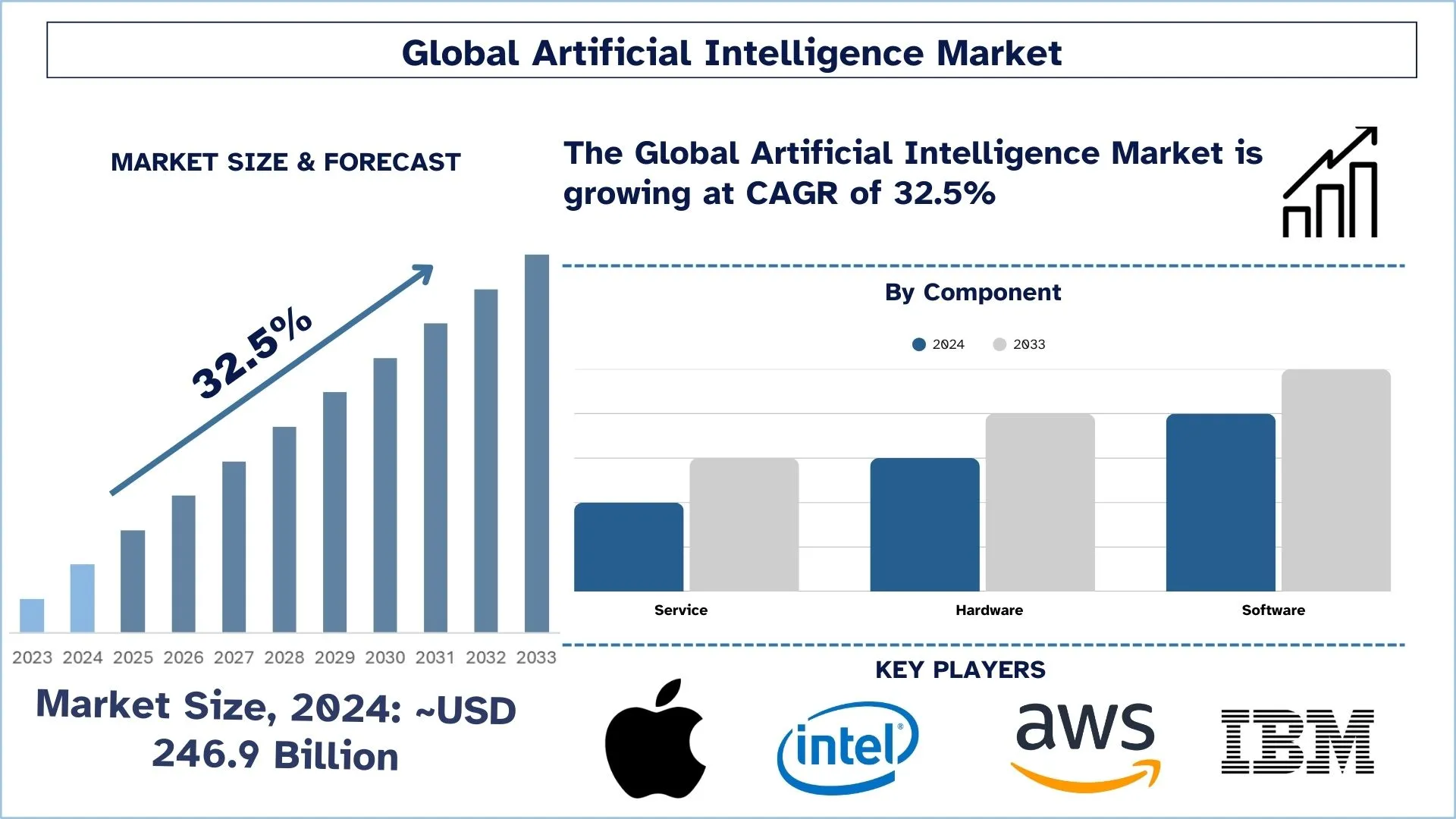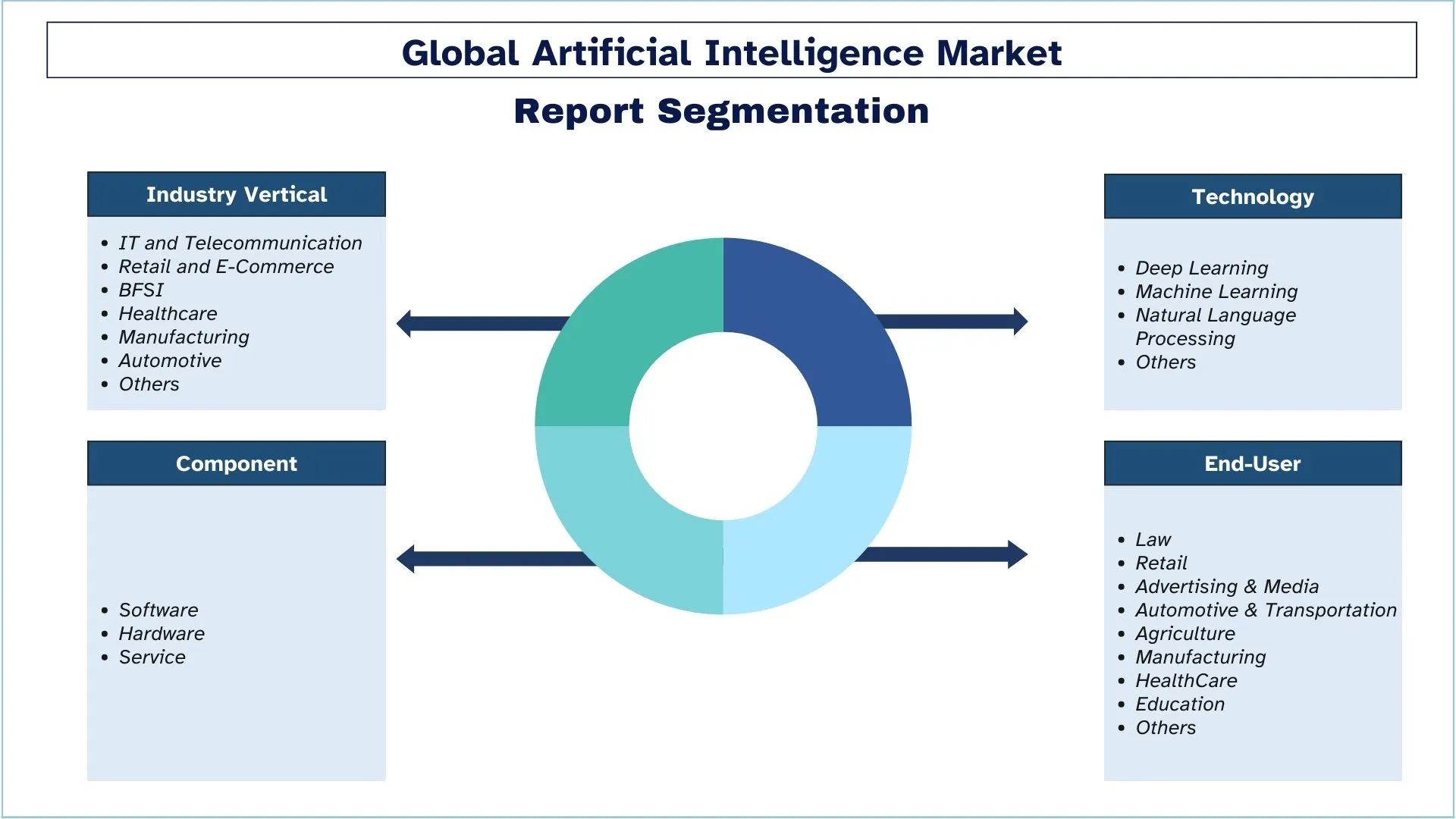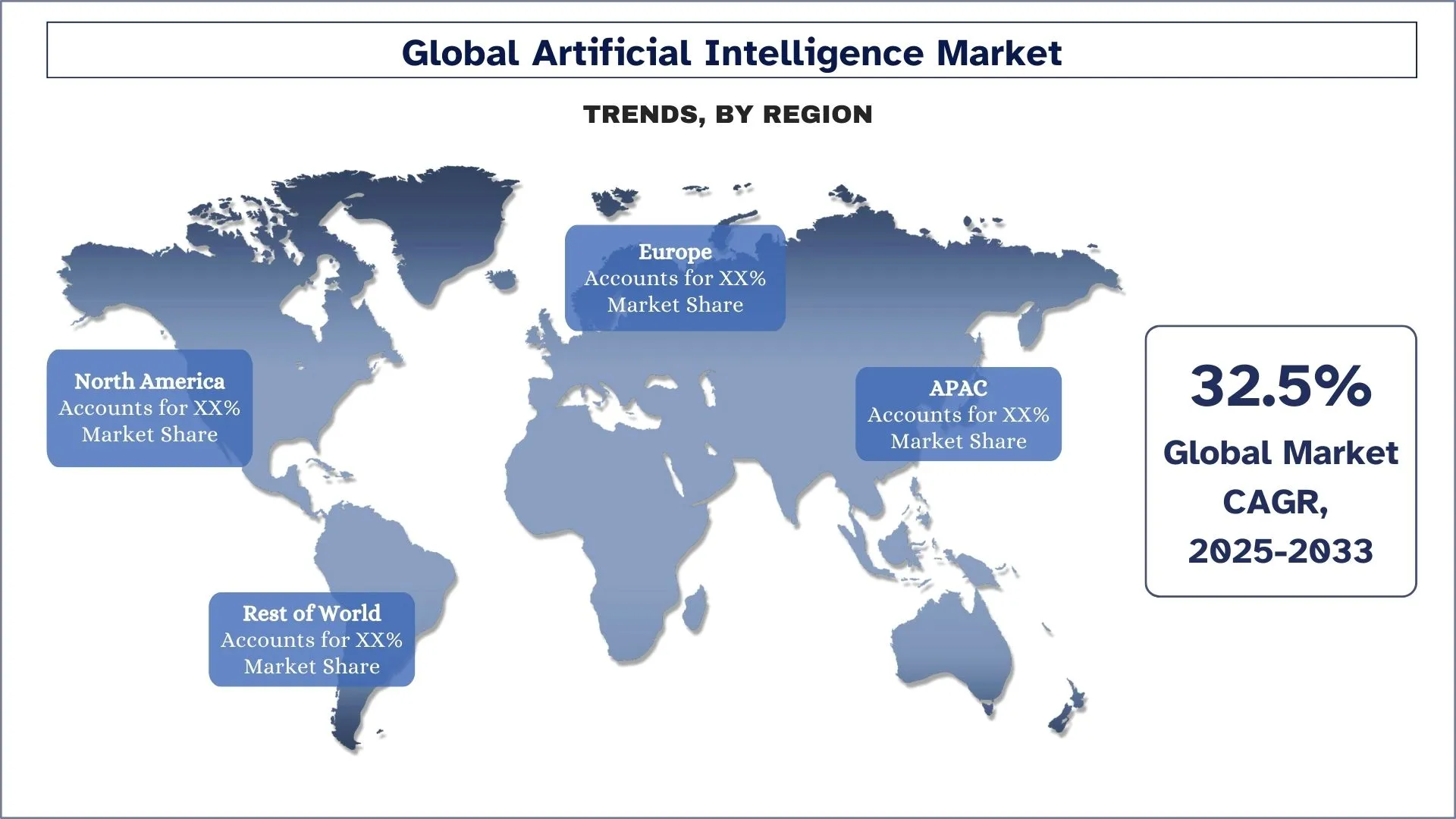- Startseite
- Über uns
- Industrie
- Dienstleistungen
- Lesen
- Kontaktieren Sie uns
Markt für künstliche Intelligenz: Aktuelle Analyse und Prognose (2025-2033)
Schwerpunkt auf Technologie (Deep Learning, Natural Language Processing, Image Processing, Sonstige), Komponenten (Software, Hardware, Services), Branchenvertikale (IT und Telekommunikation, Einzelhandel & E-Commerce, BFSI, Gesundheitswesen, Fertigung, Automobil, Sonstige), Endnutzer (Recht, Einzelhandel, Werbung & Medien, Automobil & Transport, Landwirtschaft, Fertigung, Gesundheitswesen, Bildung, Sonstige) und Region/Land.

Marktgröße und Prognose für künstliche Intelligenz
Der Markt für künstliche Intelligenz wurde im Jahr 2024 auf etwa 246,9 Milliarden USD geschätzt und wird im Prognosezeitraum (2025-2033) voraussichtlich mit einer beträchtlichen CAGR von etwa 32,5 % wachsen, was auf die steigende Nachfrage nach Automatisierung zurückzuführen ist.
Marktanalyse für künstliche Intelligenz
Es wird erwartet, dass der globale Markt für künstliche Intelligenz ein robustes Wachstum verzeichnen wird, hauptsächlich aufgrund der steigenden Finanzierung und einer Vielzahl von Anwendungen. Auch die COVID-19-Pandemie hat neue Anwendungen und technologische Fortschritte innerhalb des Sektors gefördert. Sie hat die Einführung von KI in Sektoren wie dem Gesundheitswesen gefördert. KI-basierte Tools und Lösungen werden in großem Umfang eingesetzt, um auf die Krise zu reagieren. Technologiegiganten wie Microsoft, Google, Apple, Amazon und Facebook ergreifen Initiativen in Bezug auf die Fernkommunikation zwischen Patienten und Klinikern, die Kontaktverfolgung und die Medikamentenentwicklung. Es wird erwartet, dass der COVID-19-Ausbruch das Marktwachstum von Next-Generation-Technologiebereichen, einschließlich künstlicher Intelligenz, aufgrund der vorgeschriebenen WFH-Politik (Work-from-Home) aufgrund dieser Pandemie ankurbeln wird. So hat beispielsweise LogMeIn, Inc., ein in den USA ansässiges Unternehmen, das SaaS (Software-as-a-Service) und Cloud-basierte Consumer-Engagement- sowie Remote-Verbindungs- und Kollaborationsdienste anbietet, inmitten der Pandemie einen deutlichen Anstieg der Neuanmeldungen in seinen Produktportfolios verzeichnet.
Markttrends für künstliche Intelligenz
In diesem Abschnitt werden die wichtigsten Markttrends erörtert, die die verschiedenen Segmente des Marktes für künstliche Intelligenz beeinflussen, wie sie von unseren Forschungsexperten identifiziert wurden.
Anstieg der Anwendungen für generative KI
Einer der größten globalen KI-Trends, der derzeit zu beobachten ist, ist die schnell wachsende Nutzung von generativer KI, einschließlich großer Sprachmodelle und KI-gesteuerter Inhaltserstellung. Diese Technologien verändern Branchen in dem Sinne, dass sie den Kundensupport automatisieren, Artikel schreiben und sogar Computerprogramme erstellen. Die Anwendung von generativer KI wird immer weiter verbreitet und macht Unternehmen produktiver, um die Qualität der angebotenen Dienstleistungen zu verbessern. Sie hat die Art und Weise, wie Menschen arbeiten, neu geschrieben und reagiert auf den Bedarf an Innovation im gesamten Spektrum.

Branchensegmentierung der künstlichen Intelligenz
Dieser Abschnitt enthält eine Analyse der wichtigsten Trends in jedem Segment des globalen Berichts über künstliche Intelligenz sowie Prognosen auf globaler, regionaler und Länderebene für 2025-2033.
Der Markt für Deep Learning hält den größten Anteil am Markt für künstliche Intelligenz.
Basierend auf der Technologie ist KI in Deep Learning, maschinelles Lernen, Verarbeitung natürlicher Sprache (NLP), Spracherkennung und andere unterteilt. Das Segment Deep Learning sicherte sich den größten Marktanteil am globalen KI-Markt und dominierte den Markt im Jahr 2024. Die beträchtliche CAGR in den kommenden Jahren, da NLP Computern die Fähigkeit gibt, Texte und gesprochene Wörter zu verstehen, ist NLP sehr wichtig für das Gesundheitswesen, da es einen riesigen Markt für medizinische Transkriptionen bedient.
Es wird erwartet, dass das Softwaresegment eine höhere CAGR verzeichnen wird als der Markt für künstliche Intelligenz.
Basierend auf der Komponente ist der KI-Markt in Software, Hardware und Service unterteilt. Das Softwaresegment sicherte sich im Jahr 2024 den größten Marktanteil. Das Softwaresegment ist ein wichtiger Wachstumstreiber des KI-Marktes und bietet die wichtigsten Tools und Plattformen, die für die Entwicklung und den Einsatz intelligenter Anwendungen erforderlich sind. Cloud-basierte KI-Software ermöglicht skalierbare, flexible Lösungen in allen Branchen und hilft Unternehmen, Aufgaben zu automatisieren, Daten zu analysieren und die Entscheidungsfindung zu verbessern. Sie unterstützt Funktionen wie maschinelles Lernen, Verarbeitung natürlicher Sprache und prädiktive Analysen. Da die Nachfrage nach intelligenter Automatisierung wächst, beschleunigt Software weiterhin die Einführung von KI sowohl in großen Unternehmen als auch in Startups.
Nordamerika hat im Jahr 2024 einen bedeutenden Marktanteil.
Der Markt für KI in Nordamerika entwickelt sich aufgrund der aufkommenden Technologien wie maschinelles Lernen, Robotik und Computer Vision rasant. Viele Bereiche haben eine hohe Nachfrage nach dem Einsatz von künstlicher Intelligenz, darunter das Gesundheitswesen, der Einzelhandel und das Finanzwesen. Die technologische Entwicklung der Region umfasst eine gut etablierte technologische Struktur, Technologiecluster und eine günstige Regierungspolitik. Moderne Tools werden eingesetzt, um Automatisierungen zu betreiben, Erkenntnisse aus gesammelten Daten zu gewinnen und Kunden auf verschiedenen Ebenen mit Methoden der künstlichen Intelligenz zu unterstützen.
Die USA dominieren den nordamerikanischen Markt für künstliche Intelligenz
Der US-amerikanische KI-Markt wächst jedes Jahr, vorausgesetzt, die Regierung fördert Investitionen in Forschung und Entwicklung, und weit verbreitete Bereiche sind das Gesundheitswesen, das Finanzwesen, die Fertigung usw. Das Land steht an der Spitze der KI-Entwicklung, da es von der ordnungsgemäßen Entwicklung der IT-Infrastruktur und der Universitäten profitiert. Die aufregenden Möglichkeiten bei der Anwendung von KI sind immer noch vorhanden, aber Probleme wie Datenschutz und Regulierung bremsen den Fortschritt dieser Technologie.

Wettbewerbslandschaft der künstlichen Intelligenz
Der Markt für künstliche Intelligenz ist wettbewerbsintensiv und es gibt mehrere globale und internationale Akteure. Die wichtigsten Akteure verfolgen unterschiedliche Wachstumsstrategien, um ihre Marktpräsenz zu verbessern, wie z. B. Partnerschaften, Vereinbarungen, Kooperationen, neue Produkteinführungen, geografische Expansionen sowie Fusionen und Übernahmen.
Top-Unternehmen für künstliche Intelligenz
Einige der wichtigsten Akteure auf dem Markt sind Amazon Web Services, Inc.; Apple Inc.; Google LLC; IBM Corporation; Intel Corporation; Microsoft Corporation; Nvidia; Oracle Corporation; SAP SE; und Siemens.
Jüngste Entwicklungen auf dem Markt für künstliche Intelligenz
Im März 2025 brachte ServiceNow eine Reihe von KI-gestützten Produkten auf den Markt, um die Automatisierung von Unternehmensworkflows zu verbessern. Das Angebot umfasst AI Agent Studio, ein No-Code-Tool für die Erstellung benutzerdefinierter KI-Agenten, AI Agent Orchestrator, ein Kontrollturm für die nahtlose KI-Agenten-Koordination, und Tausende von vorgefertigten KI-Agenten zur Optimierung des Betriebs und zur Reduzierung der mittleren Zeit bis zur Lösung.
Im März 2025 erweiterte die Commonwealth Bank of Australia ihre Partnerschaft und Investition in Anthropic PBC, um die Einführung von KI zu beschleunigen. Ziel der Zusammenarbeit ist es, das Kundenerlebnis zu verbessern, das Bankpersonal zu unterstützen und den Technologieexperten der Commonwealth Bank of Australia direkten Zugang zum KI-Know-how von Anthropic PBC zu ermöglichen, um eine sichere und verantwortungsvolle KI-Entwicklung voranzutreiben.
Im März 2025 gaben die NTT DATA Group Corporation und CrowdStrike, Inc. eine erweiterte Partnerschaft bekannt, um die Managed Cybersecurity Services der NTT DATA Group Corporation mithilfe der KI-nativen Falcon-Plattform von CrowdStrike, Inc. zu verbessern. Diese Zusammenarbeit kombiniert die erstklassigen Managed Services der NTT DATA Group Corporation mit den fortschrittlichen Cybersicherheitsfunktionen von Falcon, sodass Kunden die Erkennung, Reaktion und Prävention von Bedrohungen verbessern und so einen robusten Schutz vor Verstößen gewährleisten können.
Berichtsabdeckung zum Markt für künstliche Intelligenz
Details | |
Basisjahr | 2024 |
Prognosezeitraum | 2025-2033 |
Wachstumsdynamik | Beschleunigung mit einer CAGR von 32,5 % |
Marktgröße 2024 | 246,9 Milliarden USD |
Regionale Analyse | Nordamerika, Europa, Asien-Pazifik, Rest der Welt |
Wichtigste beitragende Region | Es wird erwartet, dass Nordamerika im prognostizierten Zeitraum die höchste CAGR aufweisen wird. |
Wichtigste abgedeckte Länder | USA, Kanada, Deutschland, Frankreich, Großbritannien, Spanien, Italien, China, Japan und Indien |
Amazon Web Services, Inc.; Apple Inc.; Google LLC; IBM Corporation; Intel Corporation; Microsoft Corporation; Nvidia; Oracle Corporation; SAP SE; und Siemens | |
Berichtsumfang | Markttrends, Treiber und Beschränkungen; Umsatzschätzung und -prognose; Segmentierungsanalyse; Nachfrage- und Angebotsanalyse; Wettbewerbslandschaft; Unternehmensprofilierung |
Abgedeckte Segmente | Nach Branchenvertikale; Nach Technologie; Nach Komponente; Nach Endbenutzer; Nach Region/Land |
Gründe für den Kauf des Marktberichts über künstliche Intelligenz:
Die Studie umfasst eine Marktdimensionierungs- und Prognoseanalyse, die von authentifizierten wichtigen Branchenexperten validiert wurde.
Der Bericht bietet einen schnellen Überblick über die Gesamtleistung der Branche auf einen Blick.
Der Bericht umfasst eine eingehende Analyse prominenter Branchenkollegen mit einem primären Fokus auf wichtige Geschäftskennzahlen, Produktportfolios, Expansionsstrategien und jüngste Entwicklungen.
Detaillierte Untersuchung der Treiber, Beschränkungen, wichtigsten Trends und Chancen, die in der Branche vorherrschen.
Die Studie deckt den Markt umfassend in verschiedenen Segmenten ab.
Tiefgehende regionale Analyse der Branche.
Anpassungsoptionen:
Der globale Markt für künstliche Intelligenz kann gemäß den Anforderungen oder einem anderen Marktsegment weiter angepasst werden. Darüber hinaus versteht UnivDatos, dass Sie möglicherweise Ihre eigenen geschäftlichen Anforderungen haben. Zögern Sie daher nicht, uns zu kontaktieren, um einen Bericht zu erhalten, der vollständig Ihren Anforderungen entspricht.
Inhaltsverzeichnis
Forschungsmethodik für die Marktanalyse für künstliche Intelligenz (2023-2033)
Wir haben den historischen Markt analysiert, den aktuellen Markt geschätzt und den zukünftigen Markt des globalen Marktes für künstliche Intelligenz prognostiziert, um seine Anwendung in wichtigen Regionen weltweit zu bewerten. Wir haben umfassende Sekundärforschung durchgeführt, um historische Marktdaten zu sammeln und die aktuelle Marktgröße zu schätzen. Um diese Erkenntnisse zu validieren, haben wir zahlreiche Ergebnisse und Annahmen sorgfältig geprüft. Darüber hinaus haben wir eingehende Primärinterviews mit Branchenexperten entlang der Wertschöpfungskette der künstlichen Intelligenz geführt. Nachdem wir die Marktzahlen durch diese Interviews validiert hatten, verwendeten wir Top-Down- und Bottom-Up-Ansätze, um die Gesamtmarktgröße zu prognostizieren. Anschließend wendeten wir Marktaufschlüsselungs- und Datentriangulationsmethoden an, um die Marktgröße von Industriesegmenten und -untersegmenten zu schätzen und zu analysieren.
Markt-Engineering
Wir haben Datentriangulationstechniken eingesetzt, um die gesamte Marktschätzung abzuschließen und präzise statistische Zahlen für jedes Segment und Untersegment des globalen Marktes für künstliche Intelligenz abzuleiten. Wir haben die Daten in mehrere Segmente und Untersegmente aufgeteilt, indem wir verschiedene Parameter und Trends analysiert haben, darunter Branchenvertikale, Technologie, Komponente, Endbenutzer und Regionen innerhalb des globalen Marktes für künstliche Intelligenz.
Das Hauptziel der Global Artificial Intelligence Market Studie ist es,
Die Studie identifiziert aktuelle und zukünftige Trends im globalen Markt für künstliche Intelligenz und bietet strategische Einblicke für Investoren. Sie hebt die Attraktivität regionaler Märkte hervor und ermöglicht es den Branchenteilnehmern, unerschlossene Märkte zu erschließen und sich einen First-Mover-Vorteil zu verschaffen. Weitere quantitative Ziele der Studien sind:
Marktgrößenanalyse: Bewertung der aktuellen und prognostizierten Marktgröße des globalen Marktes für künstliche Intelligenz und seiner Segmente in Bezug auf den Wert (USD).
Marktsegmentierung für künstliche Intelligenz: Die Studie segmentiert den Markt nach Branchenvertikale, Technologie, Komponente, Endbenutzer und Region.
Rechtlicher Rahmen & Wertschöpfungskettenanalyse: Untersuchung des rechtlichen Rahmens, der Wertschöpfungskette, des Kundenverhaltens und der Wettbewerbslandschaft der künstlichen Intelligenz Industrie.
Regionale Analyse: Durchführung einer detaillierten regionalen Analyse für Schlüsselregionen wie den asiatisch-pazifischen Raum, Europa, Nordamerika und den Rest der Welt.
Unternehmensprofile & Wachstumsstrategien: Unternehmensprofile des Marktes für künstliche Intelligenz und die von den Marktführern angewandten Wachstumsstrategien, um den schnell wachsenden Markt zu erhalten.
Häufig gestellte Fragen FAQs
F1: Wie groß ist der aktuelle Markt für künstliche Intelligenz und welches Wachstumspotenzial hat er?
Im Jahr 2024 wird der globale Markt für künstliche Intelligenz auf etwa 246,9 Milliarden USD geschätzt und wird voraussichtlich bis 2033 mit einer jährlichen Wachstumsrate (CAGR) von 32,5 % wachsen.
F2: Was sind die treibenden Faktoren für das Wachstum des Marktes für Künstliche Intelligenz?
Die wachsende Nachfrage nach Automatisierung und datengestützter Entscheidungsfindung in allen Branchen beschleunigt die Einführung von KI.
F3: Welcher Markt hat den größten Anteil am Markt für künstliche Intelligenz nach Komponente?
Die Software-Kategorie hält derzeit den größten Marktanteil im Komponentensegment.
F4: Was sind die wichtigsten Trends im Markt für künstliche Intelligenz?
Ein Anstieg von generativen KI-Anwendungen, wie z. B. große Sprachmodelle und KI-basierte Inhaltserstellung, verändert Arbeitsabläufe und Kreativität.
F5: Welche Region wird den Markt für Künstliche Intelligenz dominieren?
Nordamerika ist führend auf dem globalen Markt für künstliche Intelligenz.
F6: Was sind die größten Herausforderungen im Markt für Künstliche Intelligenz?
Ethische Bedenken, Fragen des Datenschutzes und mangelnde regulatorische Klarheit stellen große Hindernisse für eine verantwortungsvolle Entwicklung und Bereitstellung von KI dar.
F7: Wer sind die Top-Akteure auf dem globalen Markt für künstliche Intelligenz?
Die führenden Unternehmen, die Innovationen im Bereich der künstlichen Intelligenz vorantreiben, sind:
Amazon Web Services, Inc.
Apple Inc.
Google LLC
IBM Corporation
Intel Corporation
Microsoft Corporation
Nvidia
Oracle Corporation
SAP SE
Siemens
F8: Welche Schlüsselfaktoren sollten Unternehmen berücksichtigen, bevor sie in KI-Technologien investieren?
Unternehmen sollten bei Investitionen in KI Skalierbarkeit, Dateninfrastruktur, Integrationsfähigkeiten und potenziellen ROI bewerten. Es ist auch entscheidend, die Einhaltung von Datenschutzbestimmungen und die ethischen Implikationen des KI-Einsatzes innerhalb ihrer spezifischen Branche zu beurteilen.
Q9: Wie treiben KI-Innovationen Wettbewerbsvorteile in verschiedenen Branchen voran?
KI ermöglicht es Unternehmen, Abläufe zu rationalisieren, Kundenerlebnisse zu personalisieren, repetitive Aufgaben zu automatisieren und Echtzeit-Einblicke aus Daten zu gewinnen. Diese Innovationen verschaffen Erstanwendern einen deutlichen Vorteil in Branchen wie dem Gesundheitswesen, dem Finanzwesen, dem Einzelhandel und der Fertigung.
Verwandt Berichte
Kunden, die diesen Artikel gekauft haben, kauften auch










